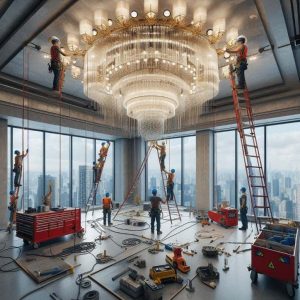Ensuring Safe Installation: A Guide to Hanging Your Modern Chandelier
 Installing a chandelier may seem simple, but safety should always be the priority. A chandelier is a decorative piece and a functional light source. If installed improperly, it can pose a significant safety risk. Whether installing a heavy, intricate fixture or a sleek, minimalist design, the key to a safe installation lies in careful planning, proper equipment, and attention to detail. Explore the essential steps and tips for safely hanging your modern chandelier.
Installing a chandelier may seem simple, but safety should always be the priority. A chandelier is a decorative piece and a functional light source. If installed improperly, it can pose a significant safety risk. Whether installing a heavy, intricate fixture or a sleek, minimalist design, the key to a safe installation lies in careful planning, proper equipment, and attention to detail. Explore the essential steps and tips for safely hanging your modern chandelier.
When it comes to hanging a modern chandelier, the first thing you need to ensure is the weight distribution. A chandelier is usually a heavy fixture; its weight can vary depending on the materials and design. If the weight is not properly distributed, it can cause the chandelier to become unstable, leading to accidents. For this reason, the support system you choose is critical. Many modern chandeliers have minimalist silhouettes that focus on sleekness and elegance, but their designs can sometimes make them seem lighter than they are. Let minimalist silhouettes define your home’s lighting with an installation system that supports the chandelier’s weight.
Choosing the Right Mounting Hardware
The next important step is selecting the correct mounting hardware. Ensure the mounting bracket is strong enough to handle the chandelier’s weight. Always follow the manufacturer’s instructions, as chandeliers have specific mounting requirements. Most chandeliers will require a secure mounting bracket that is attached to a ceiling joist. If your ceiling lacks a joist in the desired location, you may need to install an anchor to handle the fixture’s weight.
Inspecting the Ceiling
Before you begin the installation, inspect the ceiling where the chandelier will be hung. Ensure there are no cracks or weaknesses in the drywall. If necessary, use a stud finder to locate the ceiling joists. The chandelier should be anchored directly into the joists for maximum stability. If the ceiling material is particularly fragile, consider reinforcing it before installing. If you’re unsure, it’s always best to consult a professional to ensure the ceiling is suitable for holding a chandelier.
Proper Wiring and Electrical Safety
Electrical safety is another crucial aspect of chandelier installation. The chandelier must be wired correctly to avoid any risk of electric shock or fire. If you are not experienced with electrical work, it is recommended that you hire a licensed electrician to complete the wiring for you. Ensure the wiring is properly secured and the connections are insulated. When working with electrical components, always turn off the power at the circuit breaker before beginning the installation. This simple step can prevent accidents.
Positioning and Height
Once the chandelier is securely mounted, focus on positioning. Consider the height at which you hang the chandelier, as this will affect your installation’s aesthetics and safety. The chandelier should be hung about 30-36 inches above the table or floor for dining rooms or entryways. In a living room or hallway, ensure the chandelier is high enough to avoid head injuries but low enough to provide adequate light. Adjusting the height properly is important for safety and for creating the perfect ambiance in your space.
Testing and Final Checks
After the chandelier is installed and wired correctly, it’s time to test it. Turn on the power and check the fixture for stability. Ensure that all parts are securely fastened and the chandelier hangs evenly. If there is any wobbling, double-check the mounting hardware and wiring connections. It’s better to identify potential issues now than after using the chandelier. Also, check that the chandelier illuminates the space as intended, providing the right amount of light without flickering or dimming.
Maintenance Tips for Long-Term Safety
Regular maintenance is essential to keeping your chandelier safe for years to come. Periodically check the mounting hardware and wiring for any signs of wear. Dusting the chandelier regularly can also prevent the build-up of flammable materials, which could pose a fire hazard. If the chandelier begins to wobble or the light flickers, it may be time to tighten the fixtures or inspect the wiring. Regular upkeep will ensure your chandelier remains safe and functional for a long time.
READ ALSO: Tips For Keeping Your House Safe
Conclusion
Hanging a chandelier involves more than just attaching it to the ceiling. Proper installation, from selecting the right mounting hardware to ensuring the wiring is secure, is key to maintaining safety. Always prioritize safety and consider consulting a professional if you are uncertain about any part of the installation process. A modern chandelier is an investment that adds beauty and functionality to your home, but only if it is installed correctly. By following these safety guidelines, you can enjoy your chandelier worry-free.